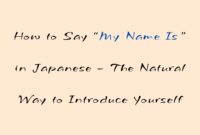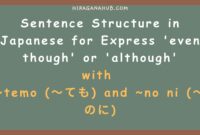Exploring the Japanese Particles “Ni” (に) and “De” (で)
Understanding the distinction between the Japanese particles “Ni” (に) and
“De” (で) enhances communication skills, as both translate to “in” in English
but have different applications.
Let’s delve into their appropriate usages.

Functions of Particle “Ni” (に)
Indicating Presence: “Ni” (に) indicates the presence of
someone or something in a static location. For example:
図書館に本があります –
としょかんにほんがあります (Toshokan ni hon ga arimasu): There are
books in the library. 台所に父がいます –
だいどころにちちがいます (Daidokoro ni chichi ga imasu): Father is in
the kitchen.
Destination Marker: This particle denotes a destination. For
example:
市場に行きます – いちばにいきます (Ichiba ni
ikimasu): Going to the market.
Time Indication: “Ni” (に) specifies when something happens.
For example:
午前中に会いました –
ごぜんちゅうにあいました (Gozenchuu ni aimashita): Met in the
morning.
Functions of Particle “De” (で)
Activity Location: “De” (で) indicates where an action
occurs. For example:
台所で料理をします –
だいどころでりょうりをします (Daidokoro de ryouri wo shimasu):
Cooking in the kitchen.
Event Location: It also marks where an event or activity
takes place. For example:
図書館で講演会があります –
としょかんでこうえんかいがあります (Toshokan de kouenkai ga arimasu):
There is a lecture in the library.
Duration or Cost: “De” (で) can denote time or cost
limitations. For example:
一時間で読み終えました –
いちじかんでよみおえました (Ichijikan de yomi oemashita): Finished
reading in one hour.
Examples and Formulas:
Using Particle “Ni” (に):
- Place + に + State verb
図書館に静かです – としょかんにしずかです (Toshokan
ni shizuka desu): It is quiet in the library.
Using Particle “De” (で):
- Place + で + Action verb
図書館で話し合います –
としょかんではなしあいます (Toshokan de hanashiaimasu): Discussing in
the library.
Vocabulary List:
| Kanji | Hiragana | Romaji | English |
|---|---|---|---|
| 図書館 | としょかん | toshokan | library |
| 本 | ほん | hon | book |
| 台所 | だいどころ | daidokoro | kitchen |
| 市場 | いちば | ichiba | market |
| 講演会 | こうえんかい | kouenkai | lecture |
This guide aims to clarify the use of “Ni” and “De,” enhancing your
understanding and usage in daily Japanese conversations. Thank you for
learning with us!


